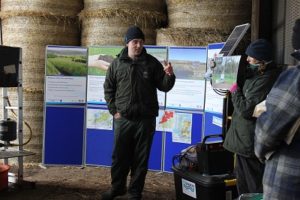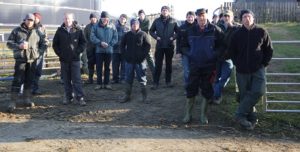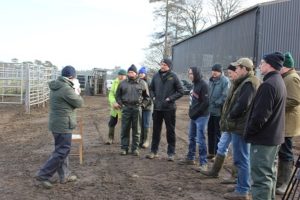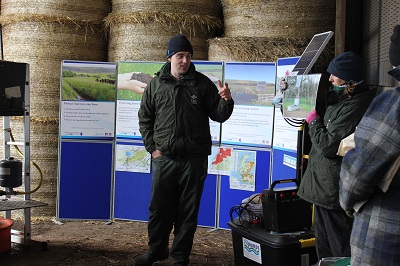Slurry, Soil & Money – event summary
27 January 2017Slurry, soil & money – It’s not what you have, it’s what you do with what you have!
There was a great turnout of approximately 45 farmers to this meeting at Bargany Mains on what turned out to be a bitterly cold day!
Introduction
Following an introduction by Chloe McCulloch, SAC Consulting, Bruce McLeary from SEPA gave an overview of the ‘General Binding Rules’ that apply to farmers/landowners & an update on the Diffuse Pollution Priority Catchment area of Dumfries. Read slides from Bruce’s presentation here. Bruce also explained the process of a ‘SEPA’ priority catchment inspection and assured everyone that it was nothing to fear, but rather that the inspectors would work with the farmer to rectify any potential diffuse pollution problems.
The historic and current SRDP funding for slurry storage and cross compliance inspections were then discussed by SGRPID. The current grant scheme open for farmers to assist in slurry storage is the Agri-Environment Climate Scheme, and applications for slurry storage will be accepted up until 30th June 2017. This is a targeted grant scheme and you can learn if you are eligible by entering your holding number on the scheme’s website. Cross-compliance inspection expectations were then discussed along with the most common breaches and problems. 
Three stations for information:
- Farming & Water Scotland were available and their primary discussion was alternative watering. Different options were available on the stand to view and the suitability for a variety of sites was discussed. Further information on alternative watering and other diffuse pollution mitigation is available on their website www.farmingandwaterscotland.org.
- Paul Hargreaves, SRUC, led a practical discussion within a field on soil health and how a Visual Examination of Soil Structure (VESS) can allow you to understand your soil and crop performance. A copy of the VESS charts are avialable to download below. Paul also discussed the benefits of controlled trafficking within your fields and how the reseach carried
 out at the Crichton Farm, Dumfries have shown some interesting benefits in crop production. ( A full download of the Valuing Your Soils booklet is available on the Farming & Water Scotland website).
out at the Crichton Farm, Dumfries have shown some interesting benefits in crop production. ( A full download of the Valuing Your Soils booklet is available on the Farming & Water Scotland website). - Chloe McCulloch led detailed discussions on the benefits of soil sampling on both whole farm or individual field basis. Chloe explained how whole farm sampling can allow you a complete overview of soil heath throughout the farm and can provide good visual management planning tools allowing efficient use of any slurry, muck or manure that you might hope to apply. The use of nutrients was discussed, including the benefits of ground vs prilled lime, timings for maximum impact & the use of digestate, slurry and muck. Knowing what your soil nutrient levels are are key to ensuring you can effectively feed the crop you hope to grow. The age and grass variety of your sward may determine the best pH to ensure the grass growth is maximised. If your grass ley is aged and has developed to tolerate an acidic soil base, by completely neutralising the soil, the sward may not respond as you might expect.
Following a very welcomed hot lunch, there was an enlightening & engaging presentation by Hugh McClymont from the Crichton Royal Farm, Dumfries, which sits within an NVZ. Hugh discussed how his management of the farm has changed with a greater reliance on soil testing information & nutrient planning through the use of PLANET software. Hugh explained his 21 day rotational grazing system & how he manages the grass growth through lesser reliance of purchased fertilisers and greater reliance of slurry. Hugh direct injects (shallow)/or uses the trailing shoe to apply the liquid portion of seperated slurry (“Miracle-Grow”) and is able to re-introduce the field into the grazing rotation two weeks later. Hugh’s final point for everyone to take home was to test what you have – know your soil analysis, test your slurry nutritional value “If you can measure it, you can manage it”.
Key Points
This successful event highlighted key areas where farm businesses can improve the efficiency of use of nutrients, by considering:
• Soil sampling for pH, P and K – so that nutrients can be targeted where they are needed, and to ensure that it isn’t pH that is holding back production.
• Take a spade and go out and look at soil structure. Some problems can be relatively easily solved once you know what you’re dealing with, and can make a big difference to grass growth.
• Sample slurry to establish exactly how much N, P and K you are applying – in some cases this will deliver all the P and K necessary.
• Don’t underestimate the value of slurry and FYM – where soil P and K levels are already good you may not need bagged P or K at all.
- Taking your own soil samples
- Technical Note (TN674): Cross Compliance Inspection Process
- A Cross Compliance inspection checks that you are meeting the rules relating to Statutory Management Requirements and Good Agricultural and Environmental Conditions.
- Topics: Rural Business
- Technical Note (TN656): Soils Information, Texture and Liming
- This technical note offers information on soil, including classification, texture, PLANET Scotland and lime recommendations.
- Topics: Soils
- Visual Evaluation of Soil Structure (VESS) Score Chart
- This is a downloadable copy of the Visual Evaluation of Soil Structure (VESS) score chart for use in-field.
- Topics: Soils
- Technical Note (TN665) – Alternative watering for field grazed livestock I – Abstraction systems
- Topics: Water Management
- Technical Note (TN666) – Alternative Watering for Field Grazed Livestock II – Pumping Systems
- Topics: Water Management
- RAM pump Information Note
- Topics: Water Management
- Solar PV Pump Information Note
- Topics: Water Management
Sign up to the FAS newsletter
Receive updates on news, events and publications from Scotland’s Farm Advisory Service



